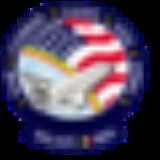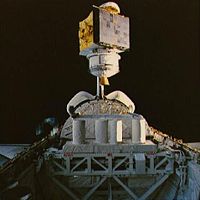
STS-61-C
Encyclopedia
Mission parameters
- MassMassMass can be defined as a quantitive measure of the resistance an object has to change in its velocity.In physics, mass commonly refers to any of the following three properties of matter, which have been shown experimentally to be equivalent:...
:- Orbiter liftoff: 116121 kilograms (256,003 lb)
- Orbiter landing: 95325 kilograms (210,155.7 lb)
- Payload: 14724 kilograms (32,460.9 lb)
- PerigeePerigeePerigee is the point at which an object makes its closest approach to the Earth.. Often the term is used in a broader sense to define the point in an orbit where the orbiting body is closest to the body it orbits. The opposite is the apogee, the farthest or highest point.The Greek prefix "peri"...
: 331 kilometres (205.7 mi) - Apogee: 338 kilometres (210 mi)
- InclinationInclinationInclination in general is the angle between a reference plane and another plane or axis of direction.-Orbits:The inclination is one of the six orbital parameters describing the shape and orientation of a celestial orbit...
: 28.5° - PeriodOrbital periodThe orbital period is the time taken for a given object to make one complete orbit about another object.When mentioned without further qualification in astronomy this refers to the sidereal period of an astronomical object, which is calculated with respect to the stars.There are several kinds of...
: 91.2 min
Mission background
STS-61-C saw Columbia return to flight for the first time since the STS-9STS-9
STS-9 was a NASA Space Shuttle mission which carried the first Spacelab module into orbit to conduct space-based scientific experiments. It was the sixth mission of the Space Shuttle Columbia, and was Columbia's last flight until STS-61-C in January 1986...
mission in November 1983, after having undergone major modifications by Rockwell International
Rockwell International
Rockwell International was a major American manufacturing conglomerate in the latter half of the 20th century, involved in aircraft, the space industry, both defense-oriented and commercial electronics, automotive and truck components, printing presses, valves and meters, and industrial automation....
in California
California
California is a state located on the West Coast of the United States. It is by far the most populous U.S. state, and the third-largest by land area...
.
The launch was originally scheduled for 18 December 1985, but the closeout of an aft orbiter compartment was delayed, and the mission was rescheduled for the following day. However, on 19 December, the countdown was stopped at T-14 seconds because of an out-of-tolerance turbine reading on the right SRBs hydraulic system.
Another launch attempt, on 6 January 1986, was terminated at T-31 seconds because of a problem in a valve in the liquid oxygen system. The countdown was recycled to T-20 minutes for a second launch attempt on the same day, but was held at T-9 minutes, and then scrubbed as the launch window expired. Another attempt was made on 7 January, but was scrubbed because of bad weather at contingency landing sites at Dakar, Senegal, and Morón, Spain; yet another attempt, on 9 January, was delayed because of a problem with a main engine prevalve, and on 10 January, heavy rainfall in the launch area led to another scrub.
Mission summary

Kennedy Space Center
The John F. Kennedy Space Center is the NASA installation that has been the launch site for every United States human space flight since 1968. Although such flights are currently on hiatus, KSC continues to manage and operate unmanned rocket launch facilities for America's civilian space program...
at 6:55 am EST on 12 January 1986. There were no significant problems reported during the launch.
The primary objective of the mission was to deploy the Satcom
SATCOM
SATCOM or Satcom may refer to:* Short for Satellite Communications and used frequently in the context of VSAT * Communications satellites or comsats...
Ku-1 communications satellite, second in a planned series of geosynchronous satellites owned and operated by RCA Americom
RCA
RCA Corporation, founded as the Radio Corporation of America, was an American electronics company in existence from 1919 to 1986. The RCA trademark is currently owned by the French conglomerate Technicolor SA through RCA Trademark Management S.A., a company owned by Technicolor...
; the deployment was successful. Columbia also carried a large number of small scientific experiments, including 13 Getaway Special
Getaway Special
Getaway Special was a NASA program that offered interested individuals, or groups, opportunities to fly small experiments aboard the Space Shuttle...
(GAS) canisters devoted to investigations involving the effect of microgravity on materials processing, seed germination, chemical reactions, egg hatching, astronomy, atmospheric physics, and the effects of the space environment on artistic materials. Also carried was a Materials Science Laboratory-2 structure for experiments involving liquid bubble suspension by sound waves, melting and resolidification of metallic samples and container-less melting and solidification of electrically conductive specimens. Another small experiment carrier located in the payload bay was the Hitchiker G-1 (HHG-1), which carried three experiments to study film particles in the orbiter environment, test a new heat transfer system and determine the effects of contamination and atomic oxygen on ultraviolet optics materials, respectively. There were also four in-cabin experiments, three of them part of the Shuttle Student Involvement Program.
Additionally, the shuttle carried an experiment called the Comet Halley Active Monitoring Program (CHAMP), consisting of a 35 mm camera intended to photograph Halley's Comet through the aft flight deck overhead window. This experiment proved unsuccessful because of battery problems.
STS-61-C encountered problems returning to Earth. It was originally scheduled to land on 17 January, but this was brought forward by one day because the delays of STS-61-C were causing the next flight, STS-51-L
STS-51-L
STS-51-L was the twenty-fifth flight of the American Space Shuttle program, which marked the first time an ordinary civilian, schoolteacher Christa McAuliffe, had flown aboard the Space Shuttle. The mission used Space Shuttle Challenger, which lifted off from the Launch Complex 39-B on 28 January...
, to be delayed. However, the landing attempt on 16 January was cancelled because of unfavorable weather at Edwards Air Force Base
Edwards Air Force Base
Edwards Air Force Base is a United States Air Force base located on the border of Kern County, Los Angeles County, and San Bernardino County, California, in the Antelope Valley. It is southwest of the central business district of North Edwards, California and due east of Rosamond.It is named in...
. Continued bad weather forced another wave-off the following day. The flight was extended one more day to provide for a landing opportunity at Kennedy Space Center on 18 January – this was in order to avoid time lost in an Edwards AFB landing and turnaround. However, bad weather at the KSC landing site resulted in yet another wave-off.
Columbia finally landed at Edwards AFB at 5:59 am PST, on 18 January. The mission lasted a total of 6 days, 2 hours, 3 minutes, and 51 seconds.
STS-61-C was the last successful Space Shuttle flight before the Challenger disaster
Space Shuttle Challenger disaster
The Space Shuttle Challenger disaster occurred on January 28, 1986, when Space Shuttle Challenger broke apart 73 seconds into its flight, leading to the deaths of its seven crew members. The spacecraft disintegrated over the Atlantic Ocean, off the coast of central Florida at 11:38 am EST...
, which occurred only 10 days after Columbias return.
Wake-up calls
NASA began a tradition of playing music to astronauts during the Gemini program, and first used music to wake up a flight crew during Apollo 15Apollo 15
Apollo 15 was the ninth manned mission in the American Apollo space program, the fourth to land on the Moon and the eighth successful manned mission. It was the first of what were termed "J missions", long duration stays on the Moon with a greater focus on science than had been possible on previous...
. Each track is specially chosen, often by the astronauts' families, and usually has a special meaning to an individual member of the crew, or is applicable to their daily activities.
| Flight Day | Song | Artist/Composer |
|---|---|---|
| Day 2 | "Liberty Bell March" | John Philip Sousa John Philip Sousa John Philip Sousa was an American composer and conductor of the late Romantic era, known particularly for American military and patriotic marches. Because of his mastery of march composition, he is known as "The March King" or the "American March King" due to his British counterpart Kenneth J.... |
| Day 3 | "Heart of Gold Heart of Gold (song) "Heart of Gold" is a song by Canadian singer-songwriter Neil Young. Released from the 1972 album Harvest, it is so far Young's only U.S. #1 single. In Canada, it reached #1 on the RPM national singles chart for the first time on April 8, 1972, on which date Young held the top spot on both the... " |
Neil Young Neil Young Neil Percival Young, OC, OM is a Canadian singer-songwriter who is widely regarded as one of the most influential musicians of his generation... |
| Day 4 | "Stars and Stripes Forever" | John Philip Sousa John Philip Sousa John Philip Sousa was an American composer and conductor of the late Romantic era, known particularly for American military and patriotic marches. Because of his mastery of march composition, he is known as "The March King" or the "American March King" due to his British counterpart Kenneth J.... |
Gag photo
During the same session as the official crew photo, the NASA photographer took a gag photo of the STS-61-C crew with their heads and faces obscured by their helmets and visors.See also
- SpaceflightSpaceflightSpaceflight is the act of travelling into or through outer space. Spaceflight can occur with spacecraft which may, or may not, have humans on board. Examples of human spaceflight include the Russian Soyuz program, the U.S. Space shuttle program, as well as the ongoing International Space Station...
- Space Shuttle programSpace Shuttle programNASA's Space Shuttle program, officially called Space Transportation System , was the United States government's manned launch vehicle program from 1981 to 2011...
- Space Shuttle ColumbiaSpace Shuttle ColumbiaSpace Shuttle Columbia was the first spaceworthy Space Shuttle in NASA's orbital fleet. First launched on the STS-1 mission, the first of the Space Shuttle program, it completed 27 missions before being destroyed during re-entry on February 1, 2003 near the end of its 28th, STS-107. All seven crew...
- Space Shuttle Columbia disasterSpace Shuttle Columbia disasterThe Space Shuttle Columbia disaster occurred on February 1, 2003, when shortly before it was scheduled to conclude its 28th mission, STS-107, the Space Shuttle Columbia disintegrated over Texas and Louisiana during re-entry into the Earth's atmosphere, resulting in the death of all seven crew members...
- Space Shuttle Challenger disasterSpace Shuttle Challenger disasterThe Space Shuttle Challenger disaster occurred on January 28, 1986, when Space Shuttle Challenger broke apart 73 seconds into its flight, leading to the deaths of its seven crew members. The spacecraft disintegrated over the Atlantic Ocean, off the coast of central Florida at 11:38 am EST...
- List of space shuttle missions
- List of human spaceflights chronologically

